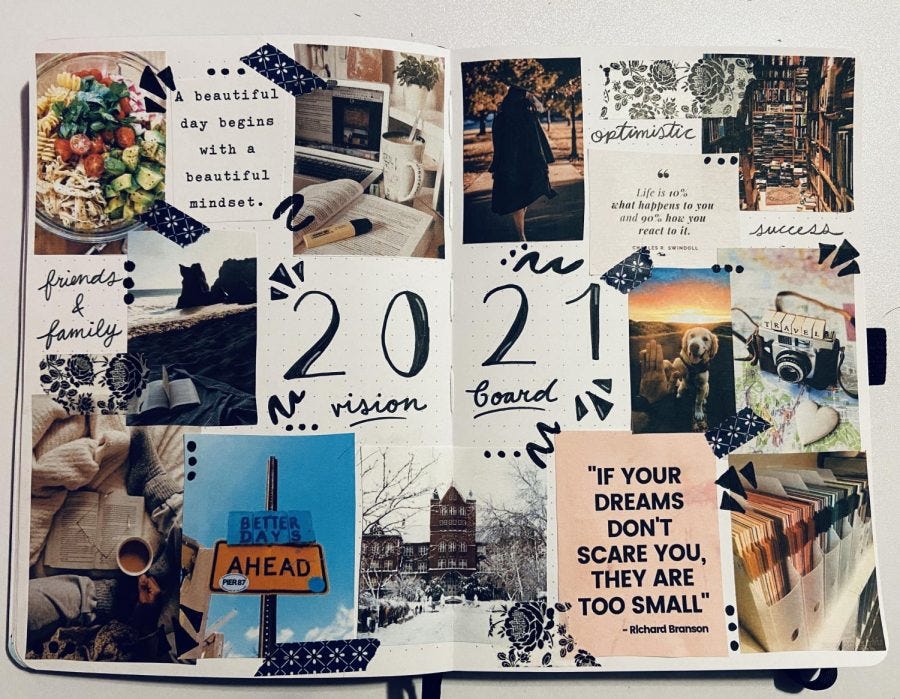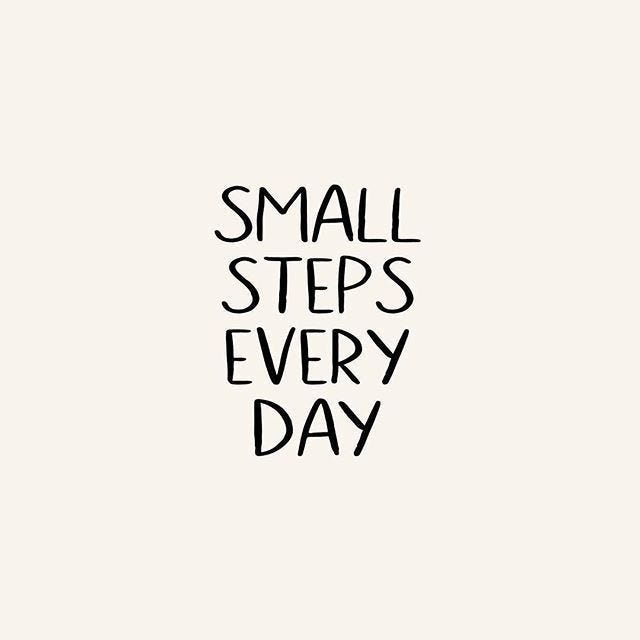set new year goals with me
vision board, monthly intentions and my tips [83]:

We are four weeks into the new year now, I hope everyone has had a good holiday season and new year so far. I started working on my New Year intentions and vision board in November because I traveled non-stop in December and wanted to set something in stone. I have one now as my wallpaper and look at it for motivation from time to time.
I have been creating my annual vision board for five years and it continued to be one of my favorite end-of-year/new year reflection exercises. I am a visual person and seeing a picture collage of my “dream “ future helps me envision how that goal is realized.
This week I want to share my intention-setting process: how I create my annual vision board and monthly intentions, my experience with their efficacy, and the mental effects they have on my general progress. I will also share some insights and tips I have collected to make this process enjoyable and realistic.
I) Annual vision board
I used Canva, a free tool to create simple designs on desktop or phone. I usually create a blank horizontal sheet and start adding pictures of the intentions/goals/future I want for myself. Here are the steps to start from scratch:
Go to Canva and create an account
Create a design, and choose something like a “Desktop Wallpaper” or “Presentation”. I like this format because there is a lot of estate to put pictures, also a bonus is that you can use the final product as your actual Desktop wallpaper if preferred.
Find pictures that fit your aesthetic and goals. Fit them onto the empty sheet however you like, whether collage style, overlapping, table, etc.
Feel free to add some text to describe your goal. For example: “Learn how to cook” or “Run my first 5K” etc.
You are always welcome to do the same thing in physical form by printing out pictures or cutting out magazines but I prefer the digital one.
This is a sample physical board:
A real vision board I made in the past:
What I love about vision boards is you can get as ambitious and loud as you want during the creation process. No one judges your aspirations, and the Internet has every picture of every scenario under the sun. I enjoy seeing vision boards as they are dynamic and inspiring compared to handwritten notes. You also can take a quick glance and have an idea of your “projected year” or the general theme, whether it is slow-living, productivity, or exploration instead of reading through a longer list.
In addition, I believe in the power of manifestation through incremental changes via habits or mindset. Having a vision board reminds me of the goals I set for myself and want to work towards. Even though there seems to be limited scientific proof for a direct relationship between manifestation and positive outcome:
Practicing positive thinking and using techniques such as reciting affirmations and visualizing can help individuals shift from negative thinking to positive. Over time, the practice of positive thinking can affect every aspect of everyday life, allowing for a new reality to take hold.
When a person commits to thinking positively and believes deep down that their goals are attainable, this can lead them to instinctively take actions toward manifesting a new reality.
At the end of each year, I like to revisit the past year's vision board and reflect. It’s also helpful to notice which goals still resonate with you to carry to the next year and which ones to leave behind. Vision boards are a good time capsule of your interests, dreams and perceptions at a point in time.
Personally, my vision board is realized 50% -60% each year. Some goals can be very ambitious and at the time of setting, I had no idea how I could achieve them. I was taken aback when one far-fetched goal started to shape up about a year after I put it on my vision board. The sky is your limit :)
II) Monthly Intention Setting
Aside from the yearly cadence of vision board, when available I also set intentions for each new month. Think of this process as either breaking down your annual goals into realistic milestones or needing to refresh or change focus each month. I don’t do all twelve months’ intentions at a time but rather work on them as the new month arrives.
I notice I can bring my intentions to the forefront if I break down big goals into monthly progress. These monthly intentions can be anything: from a specific accomplishment (get a raise at work) to a general feeling you want to have (be more present), activities you want to prioritize (have five homemade dinners a week), etc.
How I do it: In my notes app, I would jot down a few bullet points of my intentions for the month. Alternatively, you can also write them down in a physical notebook. At the end of the month, I go back and revisit what I wrote down and whether I get closer to what I set out to accomplish earlier in the month.
Here are some sample items from my past monthly intentions:
Be more dependable and knowledgeable at work
Lift weights and run more frequently
Spend quality time with family
Stay mentally healthy
Be grateful for life and everything you have
Breaking down big goals into more manageable chunks had a meaningful and sustained impact on volunteering. People who were encouraged to focus on a smaller subgoal (volunteering four hours a week or eight hours every two weeks) volunteered 7 to 8 percent more than their peers who were simply asked to hit their big goal with a little work each week - from research by Sharif et al.
The reality is “making modest goals flexible may encourage more long-term perseverance.” So one, breaking down your goals into smaller milestones and two, allowing for flexibility on the terms to achieve them.
III) Tips, tricks, and caveats
As a seasoned goal-setter who can easily be overwhelmed, here are some things to note with this process:
Set intentions with a light head and heart. Make it enjoyable or at least painless for you. If you feel too much pressure setting goals take a break and revisit later.
Set realistic and challenging goals. Don’t underestimate your capacity. It might take a few tries to strike the balance, which leads us to:
This process is iterative. Revisit, edit, change, refine everything. Nothing has to be permanent.
Show up for yourself first. Become a reliable person by doing the things you say you will do. The act of keeping your words to yourself is how you build confidence and self-trust.
Advanced tip: Struggling to hit a goal for some time? Try exploring your thinking patterns and mindset to understand what is holding you back from certain milestones. Do you believe that something is borderline impossible? Do you secretly harbor the belief that you are incompetent or not good enough? Changing your mindset helps you take more calculated risks. Personally, this is something I want to work on in 2025.
I hope you find my guide helpful. Happy goal setting! I wish you all the best in 2025 :)
Thank you for reading the Life with MD publication. This week’s post is a little bit different from my usual essays but I hope you like it.
A new essay will be up next week, subscribe for next week’s words in your inbox.
Leave me a comment or feedback.





